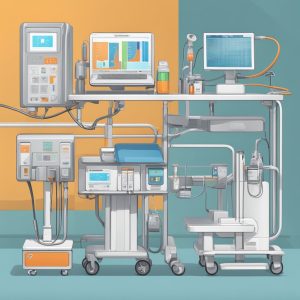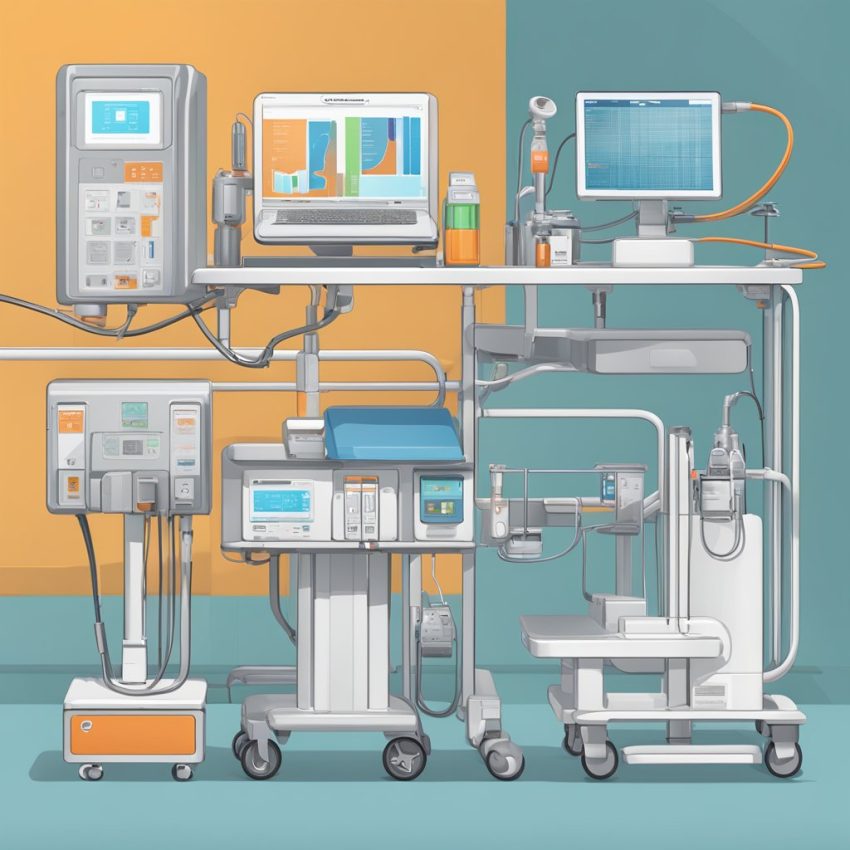Powering Medical Devices with Jackery: Features for Emergency Preparedness and Running Medical Devices

Running medical devices with a Jackery power station is a reliable and convenient solution for healthcare professionals and patients alike. Jackery power stations have many applications in the healthcare industry, providing backup power for x-ray machines, MRIs, CT scans, and other life-saving medical equipment. They can also keep lights and refrigeration running to preserve medicines. Whether you are in an emergency situation or off the grid, Jackery power stations can help ensure that your medical devices are always ready when you need them.
Understanding Jackery Power Stations is key to selecting the right one for your medical devices. Jackery power stations have different capacities, outputs, and features that can affect their compatibility and performance with medical devices. To determine the runtime of your medical device on a Jackery power station, you will need to know the wattage consumption of your device. Jackery power stations are an excellent choice for medical devices because they are lightweight, portable, and easy to use.
Jackery power stations are also an excellent choice for emergency preparedness. In the event of a power outage or natural disaster, Jackery power stations can help ensure that you have power for your medical devices and other essential needs. With features like solar charging, AC outlets, and USB ports, Jackery power stations are a versatile and reliable solution for emergency situations. Whether you are a healthcare professional or a patient, Jackery power stations can help you stay prepared and connected in any situation.
Key Takeaways
- Jackery power stations are a reliable and convenient solution for running medical devices, providing backup power for x-ray machines, MRIs, CT scans, and other life-saving medical equipment.
- Understanding Jackery power stations is key to selecting the right one for your medical devices, as they have different capacities, outputs, and features that can affect their compatibility and performance with medical devices.
- Jackery power stations are an excellent choice for emergency preparedness, with features like solar charging, AC outlets, and USB ports that make them a versatile and reliable solution for emergency situations.
Understanding Jackery Power Stations
If you are looking for a reliable and portable power source for your medical devices, Jackery Power Stations are worth considering. These power stations are designed to provide clean and efficient power for a variety of electronic devices and appliances, including medical equipment.
Core Features of Jackery Power Stations
Jackery Power Stations come with a range of features that make them ideal for emergency preparedness and outdoor activities. Some of the core features of these power stations include:
- Multiple Ports: Jackery Power Stations come with multiple ports, including standard AC outlets, USB and USB-C outlets, and DC ports, allowing you to charge and power a variety of devices and appliances.
- LCD Screen: Most Jackery Power Stations feature an LCD screen that displays important information, such as battery level, charging status, and output power.
- Compact and Portable: Jackery Power Stations are designed to be compact and portable, making them easy to carry and store. They are also lightweight, making them ideal for outdoor activities.
Battery Capacity and Power Output
One of the most important factors to consider when choosing a Jackery Power Station is the battery capacity and power output. Jackery Power Stations come in different sizes and capacities, ranging from the smallest Explorer 160 with a capacity of 167Wh to the largest Explorer 3000 with a capacity of 2932Wh.
The power output of Jackery Power Stations also varies depending on the model. For example, the Explorer 160 has an output of 100W (150W surge) for AC port and 12V/10A/120W for DC port, while the Explorer 3000 has an output of 2000W (4000W surge) for AC port and 12V/25A/300W for DC port.
Solar Charging Capabilities
Another important feature of Jackery Power Stations is their solar charging capabilities. Most Jackery Power Stations can be charged using solar panels, making them ideal for off-grid outdoor activities and emergency preparedness.
Jackery offers a range of solar panels that are compatible with their power stations, including the SolarSaga 100W, SolarSaga 60W, and SolarSaga 40W. These solar panels are lightweight and portable, making them easy to carry and set up.
Jackery Power Stations are a reliable and efficient power source for medical devices and other electronic devices and appliances. With their multiple ports, LCD screens, compact design, and solar charging capabilities, they are ideal for emergency preparedness and outdoor activities.

Selecting a Jackery for Medical Devices
When it comes to selecting a Jackery power station for medical devices, there are a few things to consider. In this section, we will cover compatibility with medical devices and calculating power requirements.
Compatibility with Medical Devices
Jackery power stations are designed to be compatible with a wide range of medical devices, including CPAP machines, oxygen concentrators, nebulizers, medical refrigerators, and specialty monitors. However, it's important to check the power requirements of your specific medical device to ensure that it can be powered by a Jackery power station.
Calculating Power Requirements
To determine the power requirements of your medical device, you will need to know its wattage and the amount of time it will be in use. For example, if your CPAP machine has a wattage of 55 watts and you plan to use it for 8 hours, you will need a power station with a capacity of at least 440 watt-hours (55 watts x 8 hours = 440 watt-hours).
To make it easier to calculate your power requirements, Jackery provides a wattage calculator on their website. This tool allows you to input the wattage and usage time of your medical device and provides a recommended power station based on your needs.
When selecting a Jackery power station for medical devices, it's important to consider the battery capacity and amps. The higher the battery capacity, the longer your medical device can be powered. And the higher the amps, the faster your medical device can be charged.
In summary, when selecting a Jackery power station for medical devices, it's important to consider compatibility with your specific medical device and calculate your power requirements using the wattage calculator. Additionally, consider the battery capacity and amps to ensure that your medical device can be powered efficiently.
Jackery in Emergency Preparedness
When it comes to emergency preparedness, having a reliable source of power is crucial. Jackery portable power stations are a great solution for maintaining power during outages and evacuation scenarios.
Maintaining Power During Outages
Power outages can happen unexpectedly, leaving you without electricity for hours or even days. This can be especially problematic if you rely on medical devices that require power to function. Jackery power stations can provide backup power to keep your medical devices running during an outage.
Before an outage occurs, it's important to make sure you have everything you need to keep your devices powered. This includes extra batteries, charging cables, and a backup power source like a Jackery power station. During an outage, you can use the power station to charge your devices and keep them running until the power comes back on.
Portable Power for Evacuation Scenarios
In some emergency situations, you may need to evacuate your home quickly. This can be challenging if you rely on medical devices that require electricity to function. Fortunately, Jackery power stations are portable and can be easily taken with you in an evacuation scenario.
When preparing for an evacuation, make sure you have a fully charged Jackery power station and all the necessary cables and adapters to power your medical devices. You should also have a list of emergency contacts and important medical information in case you need to seek medical attention while away from home.
Overall, Jackery power stations are a reliable and versatile solution for emergency backup power. Whether you're dealing with a power outage or need to evacuate your home, a Jackery power station can help ensure your medical devices stay powered and functional.
Using Jackery Power Stations for Healthcare
If you rely on medical devices to maintain your health, you know how important it is to have a reliable power source. Jackery power stations are a great solution for running medical devices off-grid or during travel. In this section, we will explore how Jackery power stations can be used to run CPAP machines and support other health devices during travel.
Running CPAP Machines Off-Grid
If you have sleep apnea and use a CPAP machine, you know how important it is to have a continuous positive airway pressure. Jackery power stations can provide you with the power you need to run your CPAP machine off-grid. Some Jackery power stations, such as the Explorer 160, are compatible with a variety of CPAP machines and can provide up to 9 hours of power on a single charge.
Supporting Health Devices During Travel
If you need to travel with medical devices, Jackery power stations can provide you with the power you need to keep them running. For instance, the Jackery Solar Generator 500 can be used to keep your CPAP running for up to 9 hours on a single charge. The Explorer 1000 is a popular option that offers 1000W of power and can charge a mobility scooter or medical device multiple times. The Jackery Explorer 2000 Plus Portable Power Station is designed to be compatible with a vast array of medical devices, including oxygen concentrators, nebulisers, medical refrigerators, and speciality monitors.
Jackery power stations are a reliable solution for running medical devices off-grid or during travel. They provide you with the power you need to maintain your health and stay prepared for emergencies.
Additional Features and Considerations
When it comes to running medical devices with a Jackery power station, there are several additional features and considerations to keep in mind. These features include design, portability, environmental impact, and sustainability.
Design and Portability
One of the key features of Jackery power stations is their sleek and compact design. These power stations are lightweight and portable, making them easy to transport and use in a variety of settings. They are also designed with user-friendly interfaces that make it easy to monitor and control power usage.
Environmental Impact and Sustainability
Jackery power stations are designed with sustainability in mind. They use high-quality lithium-ion batteries that are recyclable and have a longer lifespan than traditional lead-acid batteries. In addition, Jackery power stations can be charged using solar panels, which reduces their carbon footprint and makes them an eco-friendly alternative to traditional generators.
Overall, the design and portability of Jackery power stations make them an excellent choice for running medical devices in emergency situations. Their sustainability features also make them a great choice for those who are environmentally conscious.
Frequently Asked Questions
What types of medical devices can be powered by a Jackery portable power station?
Jackery portable power stations can power a wide range of medical devices. These include CPAP machines, nebulizers, oxygen concentrators, and other essential medical equipment.
How long can a Jackery power station sustain operation of essential medical equipment during an emergency?
The runtime of a Jackery power station depends on the capacity of the power station and the power requirements of the medical device. Jackery power stations come in different capacities ranging from 240Wh to 2000Wh. A 1000Wh power station can sustain a CPAP machine for up to 8 hours, while a 2000Wh power station can sustain it for up to 16 hours.
Are Jackery power stations capable of running a CPAP machine, and if so, which model is recommended?
Yes, Jackery power stations can run a CPAP machine. The recommended models for running a CPAP machine are the Jackery Explorer 500, Jackery Explorer 1000, and Jackery Explorer 1500.
What are the best practices for maintaining a Jackery power station to ensure reliability for medical device operation?
To ensure reliability for medical device operation, it is recommended to keep the power station fully charged and to recharge it after each use. Avoid exposing the power station to extreme temperatures and keep it in a dry and ventilated area.
Can a Jackery power station be paired with solar panels to provide extended support for medical devices?
Yes, Jackery power stations can be paired with solar panels to provide extended support for medical devices. The Jackery SolarSaga 100W solar panel is a popular option for charging Jackery power stations.
What is the maximum capacity of a Jackery power station, and how does that translate to runtime for common medical devices?
The maximum capacity of a Jackery power station is 2000Wh. The runtime of a medical device depends on its power requirements and the capacity of the power station. For example, a 2000Wh power station can run a CPAP machine for up to 16 hours, an oxygen concentrator for up to 12 hours, and a nebulizer for up to 20 hours.
Articles related to using Jackery for Emergency Power
Best Jackery for Emergency Power
Jackery for Storm Outages
A Jackery Emergency Features
Jackery Backup Power
Silent Jackery Generators
Jackery Power CPAP Machines
Jackery Air Conditioning Ports
Charge Mobility Scooters with Jackery
Jackery for Disaster Readiness





